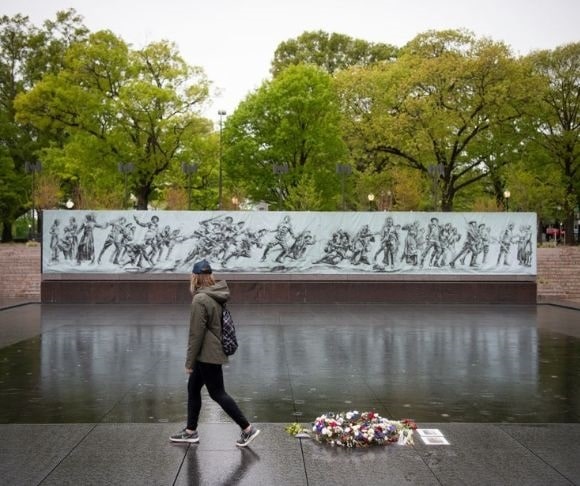On April 6, 1917, the United States formally entered World War I. Americans volunteered to go overseas and fight what was known at the time as the Central Powers: Germany, Austria-Hungary, Bulgaria, and the Ottoman Empire. The US mobilized a military force of nearly four million fighters. The price paid by American taxpayers was $23 billion, or approximately half a trillion in today’s dollars. But more tragically, when the last shot was fired, over 116,700 of our nation’s finest had fallen, sacrificing all they had to give – their lives. For 107 years, America’s other wars, police actions, and conflicts have been memorialized with impressive granite and steel structures on the National Mall in Washington, DC – yet a comparable tribute to those who served in the Great War is nowhere to be seen in the nation’s capital*. Until now, that is.
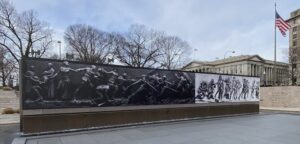
“A Soldier’s Journey” sculpture will capture and hold visitors’ attention. Surrounded by a water feature, today the interim artwork includes a photograph and composition sketch, representing what is to come. (Photo by Liberty Nation)
Sponsored by the United States World War One Centennial Commission in conjunction with the Doughboy Foundation, the American Battle Monuments Commission, and the National Park Service, sculptor Sabin Howard is creating a unique memorial. The artist is producing a bronze work of art that captures the emotion, action, agony, pathos, and triumph of the American doughboys of World War I and their anxious families. Howard’s art will be prominently placed on the National Mall in the nation’s Capital to fill the void of a long overdue remembrance.
The sculpture measures 60 feet long by 12 feet high. It features 38 individual figures and tells the story through a progressive motif of “A Soldier’s Journey,” from leaving loved ones and a wife’s touch of goodbye through the hellish trench warfare and the horrors of man-to-man, bayonet-to-bayonet combat, artillery shells exploding, and deadly, gas-filled killing fields. A shell-shocked soldier looks out at viewers with a vacant yet captivating stare. But the sculpture doesn’t end there. Last is a victory, a parade, and a return home to family, ending the “war to end all wars” saga. Each figure is purposefully and elegantly posed, and great care was taken with the minute detail of each, from the buttons on the combat fatigue uniforms to the intricacies of a cartridge belt. Howard achieved in bronze the poignancy of emotion in action – figures with “war faces” that define soldiers in conflict.
 In an exclusive interview with Liberty Nation, Sabin Howard explained the thinking and motivation behind the “A Soldier’s Journey.”
In an exclusive interview with Liberty Nation, Sabin Howard explained the thinking and motivation behind the “A Soldier’s Journey.”
Liberty Nation: Mr. Howard, thank you for taking the time to have this conversation. This project started in 2015 when the World War I Centennial Commission held a competition for establishing a World War I Memorial. You entered the initial competition but did not win. However, a 25-year-old architect Joe Weishaar won in 2016 and chose you as the artist to create the centerpiece sculpture. That was seven years ago. Did you have any idea this project would entail nearly 15% of your adult working life?
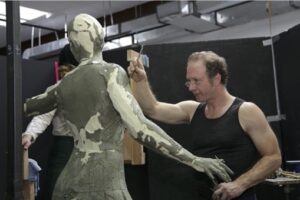
Sculptor Sabin Howard applies a coat of plasteline clay to a foam mannequin-like armature. Layers of clay will bring to life the musculature and other anatomical detail in preparation for creating a bronze figure. (Photo Courtesy of Sabine Howard)
Sabin Howard: Yes, I did know that on a deep level. On the day I found out that I had the opportunity, my reaction was, understanding the magnitude and enormity of what had been given to me, I wanted to make a historical work of art. I knew it would be a daunting task and take every ounce of energy I could muster up if I were to make something of sacred value. The sacrifice of oneself becomes all-consuming.
LN: What you describe as your vision to bronze process is not trivial. Using live models, your iPhone, and high-tech photogrammetry made this project very complex. In fact, it was an international effort involving steps of the process in China, New Zealand, and the UK. Was this your intended approach to sculpting when you started, or did it evolve?
Howard: I had never done a project like this before, with such a strict timeline and budget. That required entering into this mission with a lot of creativity to solve how, how much, how long. The project had to be world class at completion. Every aspect of my search was for the best that I could find. I’m lucky in how I create art, but also in the way things happen. I’m fortunate that I can look at a problem and then solve the problem to bring the art to reality. My vision was to use technology to do the grunt work and to apply the human touch to bring the art to reality. And it works.
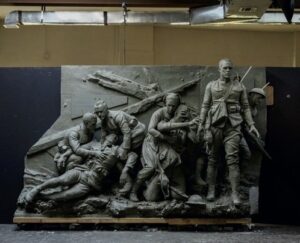
A section of the full sculpture entitled “The Cost of War,” depicts soldiers cradling a fallen comrade while a nurse, comforts a soldier suffering a deadly gas attack. “Shellshocked” soldier stares directly at viewers. (Photo courtesy of Sabin Howard)
LN: In a presentation you gave to the National Civic Art Society about two-and-a-half years ago, the progression of complex steps you go through is similar to systems engineering used on defense systems. Your wife, Traci, is the program manager. You manage and lead a talented and dedicated team. You work to a demanding integrated management plan and integrated management schedule. One doesn’t think of artists working to achieve a timeline or milestones. Does this regimen cramp your artistic vision, or is it helpful in focusing your energies?
Howard: You are working with your brain and your heart. Your art has to be universal, so you have to come to a forum that is visual language that is understandable by your eighth grader. It must be understandable to everyone who comes to the [National] Mall to understand the history of this country. It also is personal and individual because it comes from an individual artist. I don’t have any problem with the idea of bringing engineering to sculpture because that’s what great art requires.
LN: What do you want people to see in this sculpture when it’s finished; to take away from the experience?
Howard: The piece of art I’m doing is for the veterans of our country who have sacrificed their existence and mental health to preserve the constitution. The wall signifies a heroic effort, not a symbol of victimization. The memorial is multiple statements about free will. It is pro-human.
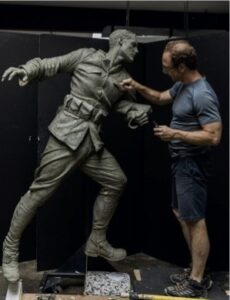
Sabin Howard applying minute detail to a soldier’s battle fatigue uniform. Figure’s dress, boots, cartridge belt, and rifles are perfectly modeled after exact articles from World War I. (Photo courtesy of Sabin Howard)
LN: We hope “A Soldiers Journey” lasts the test of decades. As you put it, “Bronze beats mortality.” Is there anything you have not been asked throughout this creative journey that you want people to know about you or the work?
Howard: I really want people to come back to a place where art is really meaningful. This art is for people and to elevate human consciousness. This is a memorial that speaks about all the human feelings that we carry with us as a species. All the feelings we carry as human beings, and it’s about a shared communion with the viewer. It’s not about the generals or great people of history but about the people at all levels of society. I also want to make art relevant again. It’s not just about entertaining the public or promoting concepts too esoteric for most people to comprehend. Art represents us, how do we want to be represented?
~
The World War I Memorial is located on the National Mall across from the famed Willard Hotel and is currently open to the public. When completed in 2024, Howard’s sculpture will be placed on the plaza of the memorial so people from around the world visiting the nation’s Capital will be able to experience “A Soldier’s Journey” for themselves. The legacy of courage the United States wants to be known for requires the visual evidence that such uncommon bravery is revered by subsequent generations. This amazing piece of art will be a source of great pride to those who fought in the Great War and a testament to America’s greatness and self-sacrifice.
*This is the first memorial in the nation’s capital, there is, however, the National World War I Museum and Memorial in Kansas City, Missouri.


